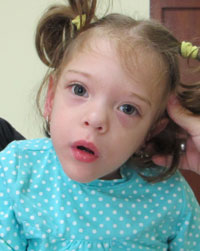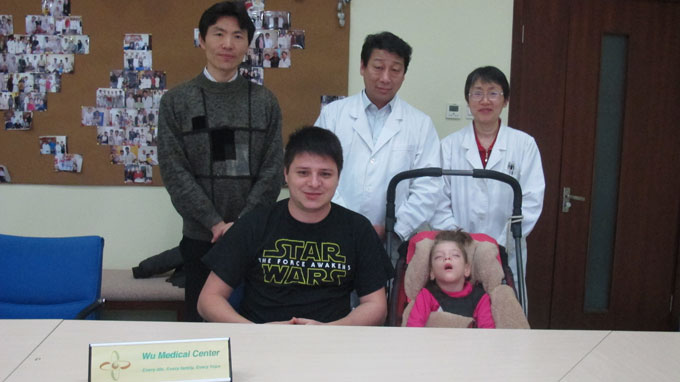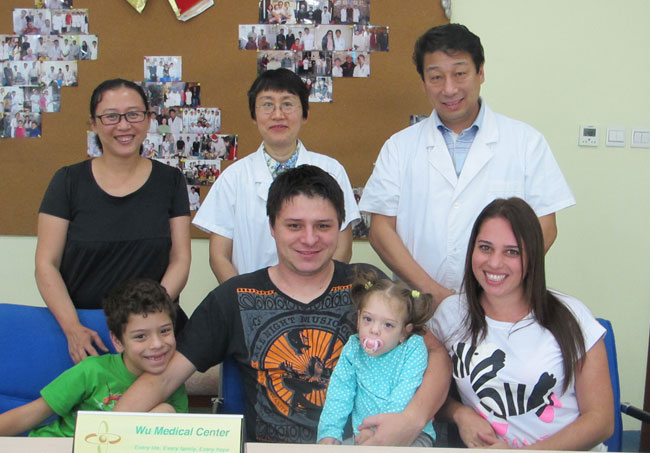Samantha Uzcategui-Cerebral Palsy-(Venezuela)-Update on March, 28th, 2016
 The second round of treatment:
The second round of treatment:
Name: Samantha Uzcategui Varela Perez
Sex: Female
Nationality: Venezuelan
Age: 3.5 Years
Diagnosis: 1. Cerebral Palsy 2. Secondary Epilepsy
Date of Admission: Jan.24, 2016
Treatment hospital/period: Wu Medical Center/21 days
Before treatment:
Samantha Uzcategui was born immaturely. She was born through Cesarean section at 27 weeks of pregnancy due to a premature rupture of the membrane. Her height was 39cm at birth and her weight was 1.15Kg. She suffered from apnoea after birth and was placed in an incubator. She needed to use a ventilator for breathing for 14 days. She was diagnosed with cerebral palsy. Then she suffered from neonate pneumonia after she was taken out of the incubator. The pneumonia was cured after 45 days of treatment. Samantha suffered from paroxysmal epilepsy when she was 6 months old. She received treatment at a local hospital and took the oral medications, sodium valproate and clonazepam. Then the symptoms were alleviated. She came to our medical center for stem cells treatment one and half years ago. After the treatment, Samantha had better awareness and her attention span increased. She was able to focus on objects longer than before, and the position of her eyeballs was better. Her vocabulary had increased and she was able to speak her name and say hello. The muscle tension of all four limbs was lower than before. There was less involuntary movements in the upper limbs. Her ability to hold objects improved. The muscles in the back and hips were stronger and she could sit up for a few seconds with someone’s help. The epileptic seizures were under control. After Samantha left our center, she took medication for 6 months and had regular physical rehabilitation training. There haven’t been any epileptic seizures for the last 2 months. Before the last 2 months, she had epileptic seizures every 3 weeks. She was in good spirits. Her vocabulary had improved and she was able to recognize familiar locations, people, body parts, food, and colors. She was more expressive with her feelings. Her vision had improved and she didn’t have to wear glasses anymore. The head and neck muscles were weaker and she couldn’t turn over, sit, stand or walk by herself. Her intelligence level was lower than that of a 2 year old child. Samantha’s family members wanted her to have a better life, so they decided to send her to our medical center.
From the onset of the disease, the patient had normal nutrition. Her sleeping patterns were normal. She ate soft food. Urination and bowel movements were normal.
Admission PE:
Body temperature: 36.3 degrees. Hr: 96/min. Br: 30/min. Bp: 90/52mmHg. Nutritional intake was bad. Samantha had slow physical development. Height: 97cms, weight: 12.5kgs. She was on a semi-liquid diet. The skin and mucosa were normal with no yellow stains or petechia. Her lips were red. The thorax was symmetrical. The respiratory sounds in both lungs were clear, with no dry or moist rales. The heart sounds were strong, the cardiac rate was normal, with no obvious murmur in the valves. The abdomen was soft and flat. There was no pressing pain or rebound tenderness. The liver and spleen were normal.
Nervous System Examination:
Samantha Uzcategui was alert and she could speak more words, she knew familiar locations, people, body parts, colors, etc. She could express her feelings, her vision was better, she didn’t need to wear glasses, she could see cartons and understand their meaning. Both pupils were equal in size and round, their diameter was 4.0mm, both pupils were sensitive to light stimulus. The eyeballs could move very well and follow moving objects. She could move well. Her swallowing ability was normal with no choking. She was unable to cooperate with the other cranial nerve examinations. The neck muscles were weak and soft. The muscle tension of all four limbs was higher. She wasn’t able to cooperate with the other muscle examinations. She couldn’t sit up, turn over, stand or walk by herself. She could turn over to her left side by herself, but it was difficult for her to turn over to the right side. Her intelligence level was lower than that of a 3 year old. The bilateral knee reflex was active, the tendon reflex was normal, the bilateral ankle reflex was positive. The bilateral abdominal reflex was normal. The bilateral pathological sign was negative. She was unable to cooperate with the examination of the senses or the coordinated movement examination. The meningeal irritation sign was negative.
Treatment:
After admission, Samantha Uzcategui received a full examination and was diagnosed with 1. Cerebral Palsy 2. Secondary Epilepsy. So she received neural stem cell injections and 4 mesenchymal stem cell injectionsin in order to activate her cells, nourish the neurons, improve the blood vessels. She also undersent physical rehabilitation training.
Post-treatment:
After 3 weeks of treatment, Samantha’s mood improved, her appetite increased and she gained 1 kg. Her cognitive ability improved and she was able to communicate better. She was able to move her head and neck more flexibly. She could turn over with some help. Her eyeballs moved more flexibly. She was able to respond to objects giving off light. Both hands could catch and hold objects better. With assistance, she was able to sit up better.

The first round treatment:
Name: Samantha Uzcategui 
Sex: Female
Country: Venezuela
Age:2 years
Diagnosis: Cerebral palsy
Date:July 30, 2014
Days Admitted to Hospital: 30 days
Medical History:
Samantha Uzcategui is a premature infant. She was born through Cesarean section at the 27 weeks of pregnancy due to premature rupture of membrane. Her height was 39cm at the birth and weight was 1.15Kg. She suffered from apnoea after birth and was placed in incubator. She received ventilator for breath for 14 days. She was diagnosed with cerebral palsy. Then the patient suffered from neonate pneumonia after she was brought out from the incubator. The disease was cured after 45 days of treatment. The patient suffered from paroxysmal epilepsy when she was 6 months old. She received treatment in a local hospital and took oral medication sodium valproate and clonazepam. Then the symptoms were alleviated. Before the treatment, the patient had normal spirit and could understood simple language. She could response through her expressions. Her hearing and vision were normal. The muscle strength of neck was poor. She couldn't turn over, sit, stand or walk. Her intelligence was lower than a normal child.
From the onset of disease, the patient had normal nutrition. Her sleep was good. She took soft food. The urine and defecation were almost normal.
Admission PE:
BP: 88/56mmHg, Hr: 102/min, Br: 26/min. Temperature: 37.0 degrees. She suffered from developmental delay. The nutrition was almost normal. Height: 80cm, weight: 9 Kg. She had semi-liquid diet. The skin and mucosa were intact, with no yellow stains or petechia. Her lips and mouth was ruddy. The thorax was symmetrical. The respiratory sounds in both lungs were clear with no signs of dry or moist rales. The heart sounds were strong and cardiac rhythm was regular, with no obvious murmur. The abdomen was flat and soft. There was no pressing pain or rebound tenderness. The liver and spleen were not enlarged.
Nervous System Examination:
The patient was alert. She had less words and only could say "mama" and "Papa". She could not cooperate with memory, orientation and calculation test. Both pupils were equal in size and round. The diameter was about 4.0 mm. Both eyes had sensitive reflex to light stimuli. Both eyes could move and follow objects. Both eyeballs stared inwardly. The movement of eyeballs was flexible. The swallowing ability was normal. There was no cough when she swallows. She couldn't cooperate with the examination of cranial nerves. The muscle strength of neck was weak. The muscle tone of her four limbs increased. She couldn't cooperate with the examination of muscle strength. She was unable to sit, stand or walk. She could turn over to left side by herself. She had difficulty to turn to right side. Her intelligence was lower than a normal 2-year-old girl. Bilateral knee jerk was active. The Achilles tendon reflex was elicited. Bilateral ankle clonus was positive. The Babinski sign was negative. She had difficulty with the examination of sensory system and coordinate movement. There was no meningeal irritation.
Treatment:
After admission, the patient was diagnosed with cerebral palsy. The patient received treatment for nerve regeneration and to activate stem cells in vivo. She was given treatment to improve the blood circulation in order to increase the blood supply to the damaged nerves and nourishment for the neurons. She also received treatment for nutritional strengthening. This was combined with daily physical rehabilitation therapy.
Post-treatment:
The patient's development is better than before. Her weight has increased to 11Kg. Her cognitive function has improved. She can focus her attention better. Both eyes can stared at object for a longer time. The eyeballs position is better than before when she stared at object. The speech function is better than before. She has much words and can say her name, hello and so on. The muscle tone of her four limbs has reduced than before. The trunk rotation has reduced than before. The involuntary movement of both upper limbs has reduced than before. She can grasp and control object slightly. The muscle strength of her waist and back has increased. She could turn over to left side and right side. With dependence on something, the patient can maintain sitting position for several minutes. The epilepsy is still under control.

E-mail:
Date: 2014-9-18
A big hello to all the team of Dr. Wu. We are sending the results of the first tests done to Samantha after 14 days of returning from China.
I also write other advances made Samantha (things she did not do before):
- It was a consultation with the ophthalmologist where it was observed that the low myopia from 3 to 2.25 and no longer has strabismus.
- He began to move his head to say "yes" and "no"
- Decreased a little weight due to travel, this weighing 10,200Kg But are already eating well again.
- Call her grandmother as "nana"
- Now she turns very easily.
- Have greater accuracy when grasping an object.
Expect your prompt response.
Love, Family Varela Uzcategui
Date: Thu, Sep 25, 2014
Good evening, I am writing about the health of Samantha.
She again performed urinalysis, bacterial culture, which did not turn out any bacteria growth, which means that no infection. The dose of her medication was adjusted according to the table sent the same day. I hope instructions for upcoming tests.
Samantha is interacting more with other children and with one of her physical therapists not crying in therapy before with all cried. Also she lets play by other people without exaltation.
Greetings to all the team,
Date: 2014-11-28
Greetings to all the team of Dr. Wu.
Samanthahas had manysignificant advances,andmanages to removeobjectsfrom a boxand dropout of it.it remains in a standing position if someone holds his hands and grip their calves.She cantake stepsif somebodyhold herhands,can evenclimb astairand lowertaking the step.She still not consolidate the head control, although the standing position she keeps her head up all the time.
She still fails the sitting position, but the trunk is much more straight and manages to stay a few seconds using her arms.
In the cognitive area, she already shown interest in certain toys to see them in the street or on the TV, she has added more words to her vocabulary.
She has become more tolerant to therapy, no cries with most of them.
We are very happy for all the advances of her.
I have a question about medications. When completed 6 months of treatment, the medication is discontinued or the dose gradually going down?
Another question, is needed again some blood tests?
I hope your answers, greetings to all,
with love
Family Varela Uzcategui
